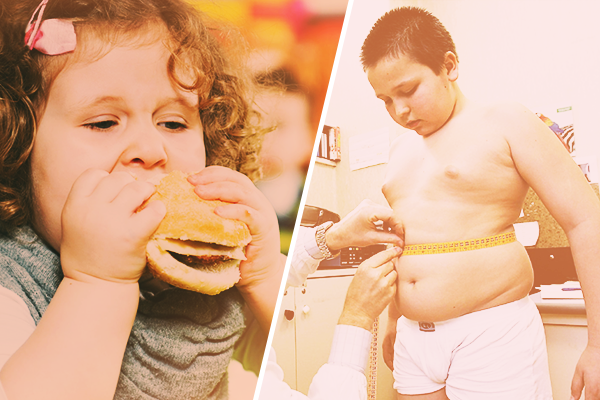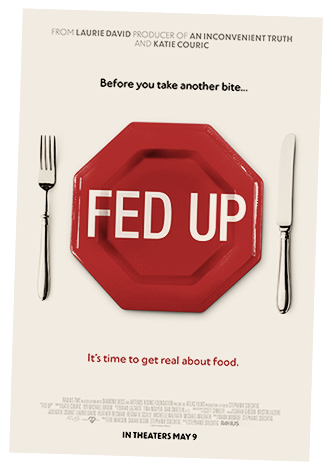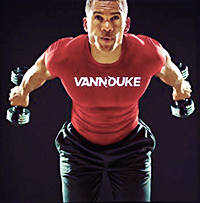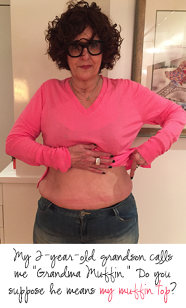An alarming documentary I watched last weekend, called Fed Up, prompted me to text my daughter, who has an 18-month old son:
“Don’t ever give Primo any cold cereals or other supermarket foods that have tons of sugar, even if the boxes say low fat or no fat. It’s scary what’s happening with children’s health in America because the food industry is producing such crap.”


I challenge anyone to watch this 95-minute documentary without having a similar reaction. Even if you’re smart enough to keep yourself and your family far, far away from processed foods, you’ll be shocked to learn just how much they’ve contributed to the snowballing childhood obesity epidemic, the likes of which the world has never before seen.
First consider these two ridiculous, well-known facts:
- American auto companies freely manufacture (and sometimes even surreptitiously sell) defective cars that can kill us
- American tobacco companies knowingly produce cancer-causing cigarettes
Here’s a third equally ridiculous fact, that isn’t as well known; as a matter of fact, it’s one of America’s best-kept, dirty-little secrets: The mammoth American food companies knowingly make cereals, cookies, frozen breakfasts, lunches and dinners—hundreds of thousands of processed foods—that are creating a “tsunami of sugar” sweeping up our children and putting them at precipitously high risks for developing cancer, stroke, diabetes and heart disease.
And nothing is stopping these companies from continuing this despicable practice
Not Michelle Obama (although she’s tried with her Let’s Move campaign). Not our schools, 80 percent of which have deals with companies, including Coke and Pepsi, to serve junk food and beverages to our children and grandchildren. Not parents, who succumb to the lures of food marketing, on TV, on the internet and  around practically every corner they turn. And certainly not our children.
around practically every corner they turn. And certainly not our children.
Yep, that’s right. One in five children today is obese, compared to one in 20 in the past. Obesity isn’t just unattractive and sloppy. It leads to chronic illness. Imagine an eight-year-old giving himself insulin shots. You don’t have to imagine. It’s happening. It really is. Once limited to adults, Type 2 diabetes has become a childhood disease.
The amount of added sugar in the 600,000 processed foods currently manufactured in America is horrifying. Sugar isn’t just in cookies and desserts; 80 percent of our processed foods have added sugar. Our kids are becoming sugar addicts. The American Heart Association recommends a daily sugar intake for women of 6 to 9 teaspoons, but our daily intake is actually 41 teaspoons.
If we keep traveling down this sugar-paved road, it’s estimated that 95 percent of all Americans will be obese in the next two decades.
The seeds of the epidemic actually were planted in 1977, after a government committee on nutrition and human needs heard expert testimony that obesity was the #1 form of malnutrition in the US, caused by a diet overly rich in saturated fats, rich in sugar, rich in fatty meats and rich in cholesterol. When the committee report recommended the creation of dietary “goals” for Americans—that we reduce our intake of fat-rich, caloric food—the egg, dairy, beef and sugar associations united, rejected it and demanded a rewrite.
If Americans reduced their intake of fat-rich, caloric food, that would translate into less business, the food industry correctly reasoned. Can’t have that, manufacturers thought, so they started getting creative, and devious:  They re-engineered their food with less fat and fewer calories, but began dumping in more sugar to make it taste better. Otherwise, the food would have tasted like cardboard. That’s when the marketing gurus stepped in and designed labels that made bold statements, such as: “Now with half the fat and one-third fewer calories.” What the labels didn’t say was that the re-engineered food contained twice the sugar. The upshot? Americans doubled their daily intake of sugar from 1977 to 2000.
They re-engineered their food with less fat and fewer calories, but began dumping in more sugar to make it taste better. Otherwise, the food would have tasted like cardboard. That’s when the marketing gurus stepped in and designed labels that made bold statements, such as: “Now with half the fat and one-third fewer calories.” What the labels didn’t say was that the re-engineered food contained twice the sugar. The upshot? Americans doubled their daily intake of sugar from 1977 to 2000.
Remember when the heads of the tobacco companies “lied through their teeth” about the dangers of smoking, the film asks? Everyone watching the lineup of tobacco execs seated before Congress knew they were calculating clowns, but we let them get away with it. Until we didn’t. And when the government, media and the public finally took on the tobacco companies, in the mid 90s, changes were swift and effective. Smoking ads were banned on TV; smoking was banned in planes, in the workplace, in restaurants. Labels on cigarette packs were honest. The fact is, we should ban smoking entirely, but the tobacco lobby is too strong, so we’re settling for second best. The good news is that half as many high school students are smoking now than they did 20 years ago.
Well, my dear FOFriends, the documentary claims that the food companies have been lying through their teeth for the last 30 plus years about the damage that sugar is causing to the health and well being of our children. And we will have to “demonize the food industry, like we demonized the tobacco industry,” if we are going to cure obesity, the documentary emphatically states.
I’m ready. Are you?
Here are 19 other crucial facts and statistics I gleaned from Fed Up about the obesity epidemic and the effect of sugar on our children’s (and, of course, our) health.
(more…)
 That’s not all:
That’s not all:






 I’m ending Week 4 of my belly-busting routine, and I’m starting to see a difference in my body, based on how my ‘boyfriend” jeans fit.
I’m ending Week 4 of my belly-busting routine, and I’m starting to see a difference in my body, based on how my ‘boyfriend” jeans fit.


 around practically every corner they turn. And certainly not our children.
around practically every corner they turn. And certainly not our children. They re-engineered their food with less fat and fewer calories, but began dumping in more sugar to make it taste better. Otherwise, the food would have tasted like cardboard. That’s when the marketing gurus stepped in and designed labels that made bold statements, such as: “Now with half the fat and one-third fewer calories.” What the labels didn’t say was that the re-engineered food contained twice the sugar. The upshot? Americans doubled their daily intake of sugar from 1977 to 2000.
They re-engineered their food with less fat and fewer calories, but began dumping in more sugar to make it taste better. Otherwise, the food would have tasted like cardboard. That’s when the marketing gurus stepped in and designed labels that made bold statements, such as: “Now with half the fat and one-third fewer calories.” What the labels didn’t say was that the re-engineered food contained twice the sugar. The upshot? Americans doubled their daily intake of sugar from 1977 to 2000.